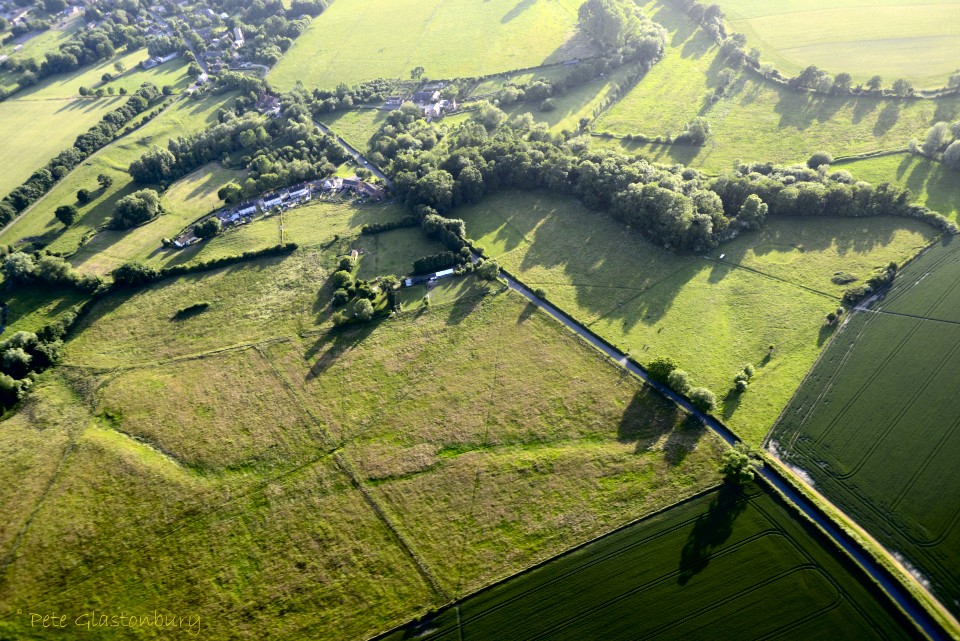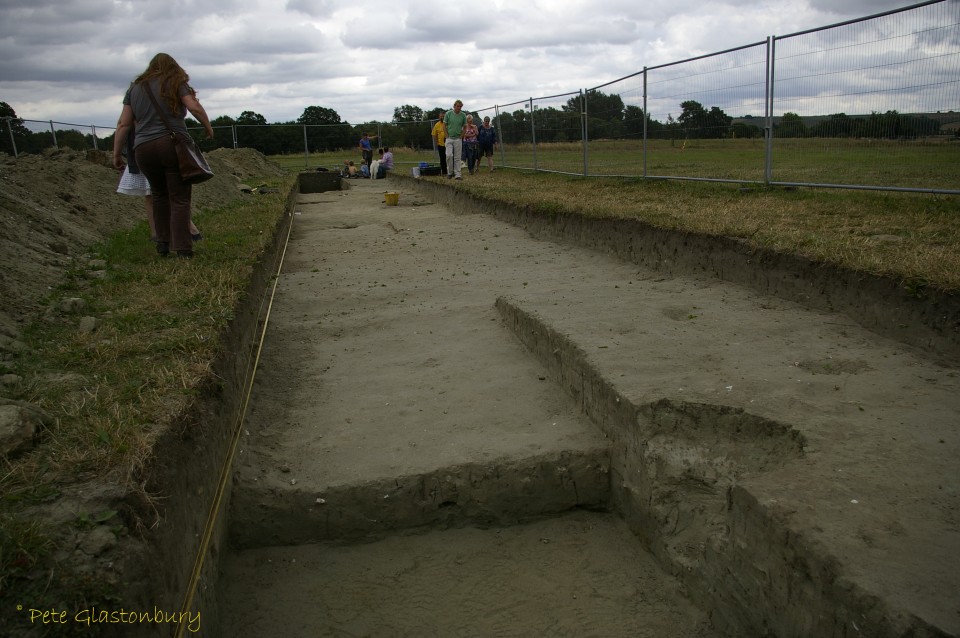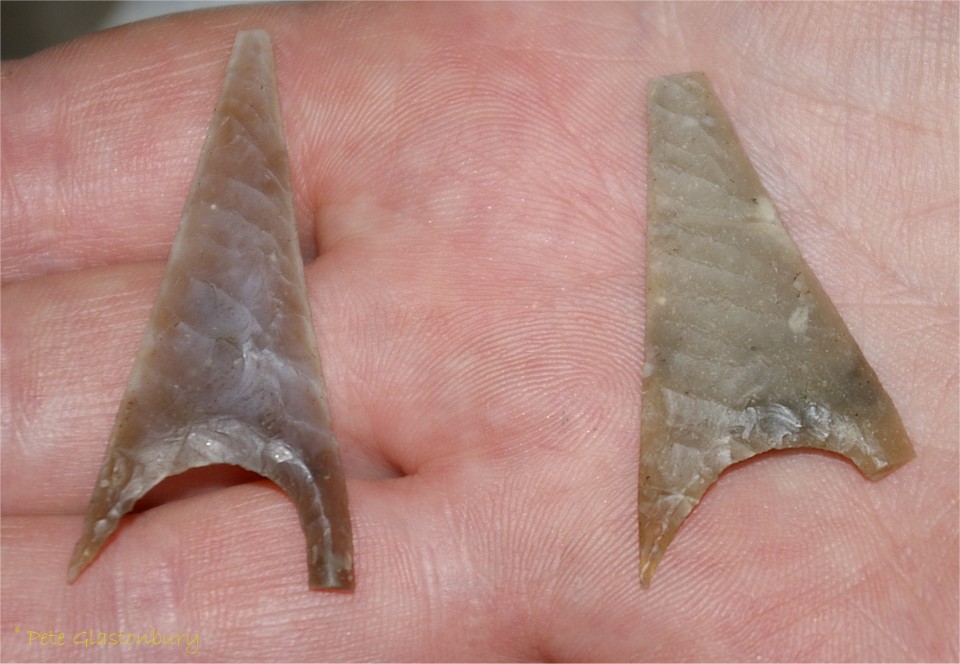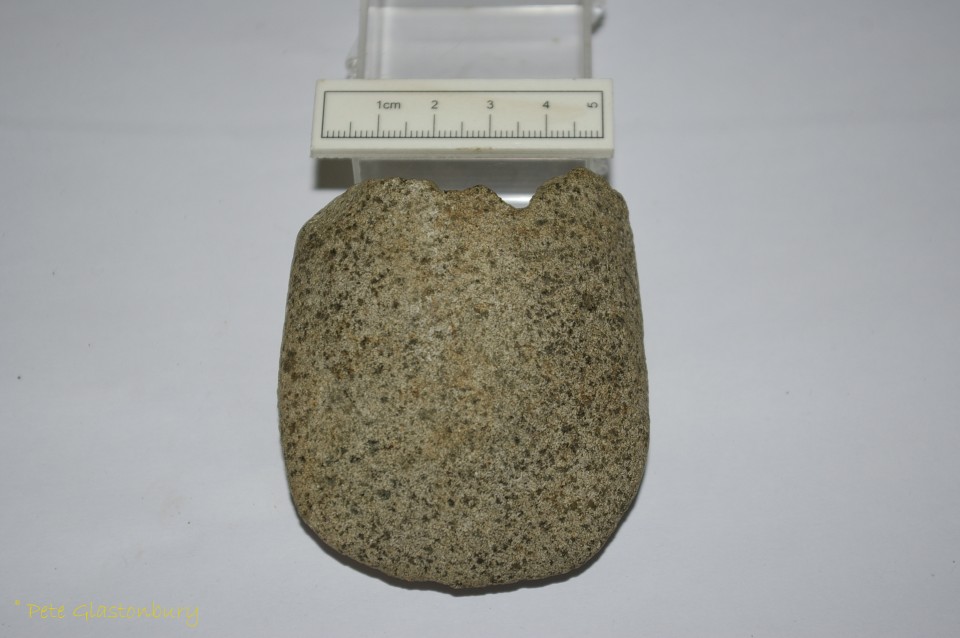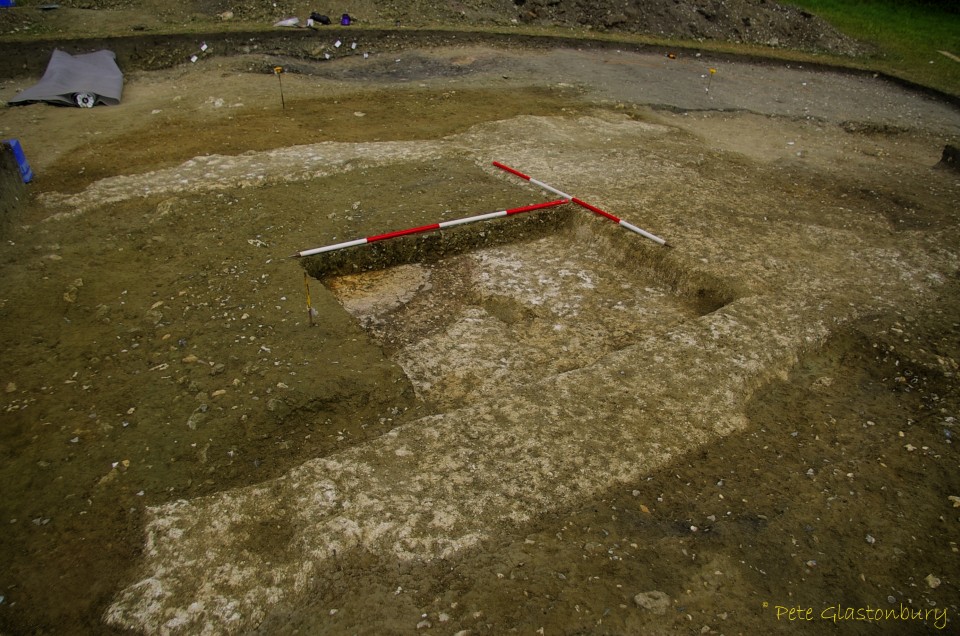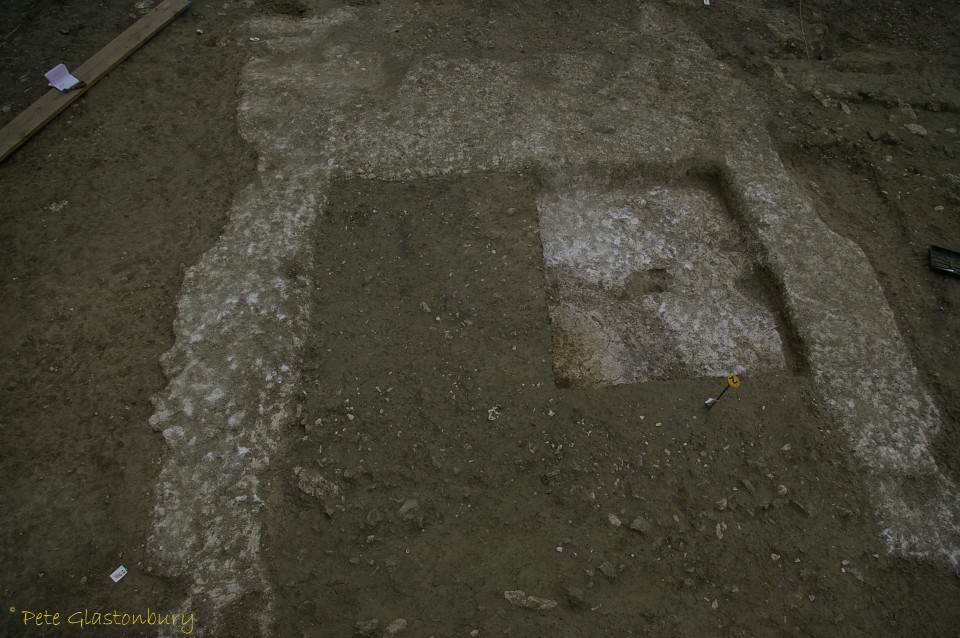Thank you Pete Glastonbury for the above aerial view of the site of Marden Henge.
On 15 June 2015 the University of Reading announced in a press release:
‘Archaeologists are embarking on an exciting three-year excavation in the Vale of Pewsey, Wiltshire. Situated between the iconic prehistoric monuments of Stonehenge and Avebury, the Vale of Pewsey is a barely explored archaeological region of huge international importance. The project will investigate Marden Henge. Built around 2400 BC, ‘Marden’ is the largest henge in the country and one of Britain’s most important but least understood prehistoric monuments.’
The full press release is here, and prompted me to look a little more closely at earlier writings on the subject of Marden Henge.
A previous two-year English Heritage excavation at Marden Henge concluded in 2010 and Mr. Mike Pitts published an article relating to the excavation at Digging Deeper here, on 8 August 2010.
A Historic England overview of Marden Henge is here on Pastscape and their National Mapping Programme is here.
‘I have just received a letter from Mr. Mayo, the clergyman who lives near Marden … His account somewhat staggered me … ‘ – Richard Colt Hoare, September 1807.
‘I shall make a long paper of Marden and, giving my opinion, I hope I shall do it modestly, and leave others to think as they please … Mr. (Rev.d Francis) Wise says “Where history is silent and the monuments do not speak for themselves, demonstration can not be expected, but the uttermost is conjecture supported by probability.’ – William Cunnington, October 1807.
‘Marden is a Wiltshire village approaching midway between Avebury and Stonehenge. It has a huge henge that is larger than Avebury. The henge has a unique feature of two entrances at right angles to each other on north and east sides, and a ditch 40 feet wide. It had a ‘Giant’ mound that John Aubrey claimed was second only in size to Silbury Hill.’ – Brian Edwards.
‘Marden Earthwork … Late Neolithic henge monument roughly oval in plan enclosing 35 acres. On the S and W it is defined by the River Avon, elsewhere by a massive bank and ditch, now reduced by ploughing. There are at least two entrances, on E and NW. Excavations at the latter in 1969 produced quantities of Grooved Ware, flints, antler picks, and animal bones. Remains of a small circular timber structure were found just within the entrance.’ – Nikolaus Pevsner, The Buildings of England: Wiltshire 2nd ed, 1991.
Hatfield Barrow, constructed from greensand and within Marden Henge, described here, the ‘Giant of Marden’ is no longer visible. ‘Ploughing in the mid-nineteenth century ensured there was apparently no trace left of the barrow by the 1860s.
We have taken sections, etc., of the gigantic tumulus, which I think had a connection with Silbury Hill, for before its summit was levelled they must have been seen from each other.’ – Sir Richard Colt Hoare, 22 March 1806.
The above image is courtesy of Pete Glastonbury, who states, ‘This is a trench across the bottom of the Hatfield Barrow, second only to Silbury (in size). The post hole marks the center of the mound and the ditch is at the far end where people are digging.’
‘Similar to Silbury in shape but not in construction, the Marden ‘Giant’ barrow was investigated by William Cunnington, who abandoned the mound to the elements after ‘opening’ it in 1807. Subsequently pummelled by the weather with the messy remains flattened by the farmer, the great barrow disappeared inside a decade.’ – Brian Edwards.
‘Mild and fine day. Went in a chaise to Marden. Our workmen had a most providential escape by being taken off to another spot by Mr. Cunnington, when, during their absence, several ton weight of earth fell at a time when the floor of the barrow was nearly uncovered … The manoeuvres for the day being interrupted by the heavy fall of earth. I left Marden and ascended the chalk hills.’ – Richard Colt Hoare, 10 October 1807.
‘The precise plan is not certainly known, but it is possible that the earthwork extends south of the River Avon and that part of the river runs through it.’ – Leslie Grinsell, The Archaeology of Wessex 1958.
‘Being on a tributary to the Avon, Marden Henge links with Durrington Walls and Stonehenge, and, like the former, there is evidence of considerable Neolithic occupation at Marden, where the remains of a wooden building over 30 feet across was found inside the henge. Although larger in size, Marden also has similarities with Avebury, and apart from being almost midway between Avebury and Stonehenge, Marden’s historic landscape development is rather reminiscent of Avebury.
‘Even a walk through Marden can remind you of Avebury, minus the traffic, that is. If for the moment you can imagine yourself on the footpath from Little Avebury (Truslow, Truslowe or Trusloe) heading into Big Avebury, you come across a manor house and grounds to your left, then you walk among village houses for quite a distance, then there is a church on your left, then you are inside the henge, then after quite a lengthy step it all of a sudden disappears. That is what it is like at Marden!” – Brian Edwards.
‘You will find every farmer in the parish an antiquarian, who will not only tell you who erected these works but also who remembers the battle that was fought under Broadbury Banks, to which event these works at Marden are connected!’ – Philip Croker, 14 March 1805.
Above, ripple flaked arrowheads found during the previous excavations in 2010. (Picture courtesy Pete Glastonbury)
‘If we consider that where the tributary to the River Kennet is at Avebury, the stream at Marden runs into the Christchurch Avon, the comparison proves quite a coincidence. Where Avebury has a Saxon settlement beneath the south car park, Marden has a settlement beneath the Glebe. Both sites have communities similarly positioned relative to their respective churches. The church at Marden is dedicated to All Saints as was Avebury Church until it was changed to St. James, and the similarity doesn’t end there.
‘Present day villages at Marden and Avebury share a similar layout along the route of their henges. Where Avebury expanded along its main street and into the henge, Marden similarly expanded along a road without it being such a main thoroughfare. In the case of Marden the village expanded away from the henge, but perhaps more pertinently away from the river and on higher ground. Avebury would have increasingly got its feet wet by expanding any further away from the henge, so perhaps encroachment on the henge was inevitable once a street developed along the path of a stone avenue.’ – Brian Edwards.
‘The evidence from Marden, so close to Avebury, the silting of Waulud’s Bank (Beds), and the absence of waterlogging at Avebury, all argue against the theory that its ditch had ever been a moat, and an alternative explanation must be sought for its depth.’ – Aubrey Burl, Prehistoric Avebury, 1979.
‘I am of the opinion it had a circle or circles of stones set round the area on the verge of the ditch similar to Abury; for in passing the narrow bridge and horse path from the Mill to the Work, you perceive a great many sarsen stones in the water. These stones are not so large as those in the outer circle of Stonehenge, yet several of them are as large as those in the inner circle of the latter place. A farmer told me he thought they were brought from Kennet and placed there to protect the banks of ye river from being washed down by the stream; but this is by no means probable. On a road a little way from the mill is a sarsen much larger than those in the water.’ – William Cunnington, May 1806.
The above photograph, courtesy of Pete Glastonbury, is of a hand axe found in a garden by a Marden resident who bought it along to show the archaeologists excavating at Marden Henge in 2010.
‘Sarsen stones are noticeable by their absence at Marden, despite the location being midway on a route between Avebury and Stonehenge. Although a few small examples of sarsen stone can be found in the bridges and in Marden Church there is nothing obviously suggesting there were sarsens standing in the vicinity … There are also sarsen shards in fields to the west and several large stones were found when trees and hedges were planted for the ‘Millennium’, but although Marden Henge is contemporary with Avebury Henge it is not similarly located adjacent to the natural source of sarsen. We would therefore not expect to find as much sarsen in subsequent buildings, but as Marden is on greensand, a large sarsen would sink if it wasn’t supported on a very wide base. Perhaps this is why there are large stones at Avebury and Stonehenge, but not at a site midway between.
‘It is not the lack of stones that sees Marden fall outside the ranks of Avebury and Stonehenge, however William Cunnington thought Marden the most important site next to Stonehenge and Avebury, but Marden is not ranked alongside the two stone circle sites in terms of World Heritage Site status because less survives.
‘Marden lost its ‘Giant’ mound when the weather flattened the remains, lost its ditch when it was filled up by the plough, and its pub closed its doors on 7 January 2000 when the landlord returned after 35 years. On the other hand, Marden has not suffered the ravages of the heritage industry, and the subsequent annual toll of tourism.
‘Marden has much of that longed for at Avebury and Stonehenge. It has the solitude sought at Stonehenge, fewer buildings than Avebury, and far less traffic than either stone circle site. This is because there is so much less to see. Much less to see means no World Heritage Site status, no WHS means fewer tourists, less attention means secret.’ – Brian Edwards.
During the previous English Heritage excavations ending in 2010, a Neolithic House was discovered inside Marden Henge. Dr. J. Leary, Project Director, describes the house as ‘the best-preserved Neolithic building in England. It wasn’t a house that was lived in, but probably had some other function – perhaps a sweat lodge. The people that used this building will have seen Stonehenge in use – perhaps even worshipped there. There may be more buildings at Marden, and this is one of the questions we need to answer.’ The full article is here.
A hearth was also discovered inside the Neolithic building and shows up as a partial circle in the centre of the above photograph (courtesy of Pete Glastonbury). Most of it was left unexcavated.
During excavations in 2010, a thick deposit of gravel was recorded on top of the causeway to the south, echoing mildly Lt. Col. Hawley’s description of the southern causeway at Stonehenge during excavations in the 1920s, stating that it was ‘flinty and hard from traffic over it.’
With three years of excavations at Marden Henge by the University of Reading ahead, expectations are now high for the Cinderella sibling of Stonehenge and Avebury.
More on Marden Henge :
Megalithic Portal here.
The Modern Antiquarian here.
Thank you Brian Edwards and Pete Glastonbury for assistance with this article, and use of copyrighted materials.

